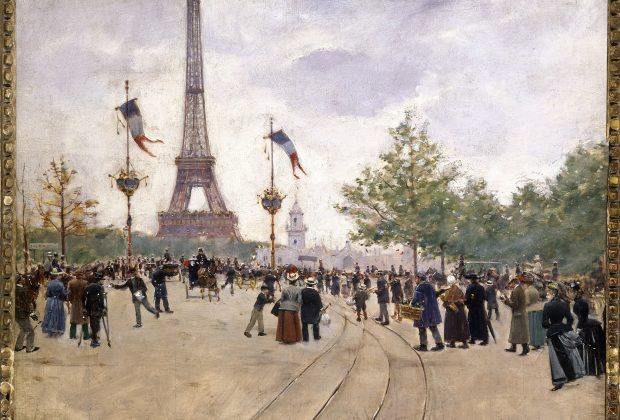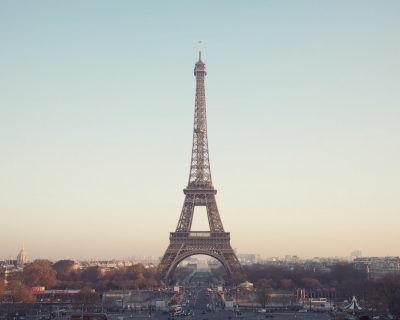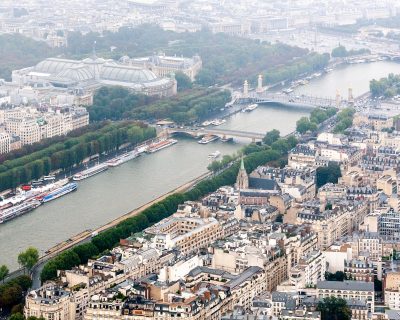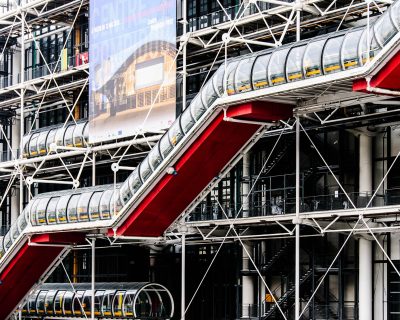The Eiffel Tower has inspired painters and poets ever since it was built in 1889 to celebrate the centennial anniversary of the French Revolution. Some artists thought it was the ugliest man-made construction they had ever seen. Others thought it a masterpiece, an exciting symbol of how modern France was.
Today, most people think of the Eiffel Tower as a symbol of love or simply a beautiful emblem of Paris. It’s one of the most popular attractions in the world. We love it — after all, we created the world’s first climbing tour of the Eiffel Tower — but it’s fascinating to see what artists have thought of it over the years.
Following up on my post about the Eiffel Tower in movies, I wanted to share the many places the tower shows up in art. I also included a couple recommendations for (free!) Paris museums where you can see some of this art yourself.
From pointillism to something called a calligram, the Eiffel Tower has been written about and recreated by all kinds of artists. Here are a few of my favorites.
The Eiffel Tower in literature
Joris-Karl Huysmans (1848-1907), a French novelist and art critic didn’t like the tower one bit. In 1889, he wrote that Eiffel’s “tower looks like a factory chimney under construction, a carcass waiting to be filled with cut stones or bricks. It’s hard to believe that this funnel-shaped metal net is finished, that this solitary suppository shot through with holes is going to stay as is.”
And he goes on for several paragraphs more!
Fun fact: A Parisian street is named after Huysmans in the 6th arrondissement.
Guy de Maupassant (1850-1893), a short-story writer, mentioned the Eiffel Tower with some asperity in “La vie errante” in 1890. Here’s what he says:
“I left Paris and even France, because I ended up bored stiff by the Eiffel Tower. Not only is it visible from everywhere, but it is everywhere, made of all known materials, exposed in every shop window, an inevitable and torturing nightmare. It was not only the tower, moreover, that gave me an irresistible desire to live alone for a while, but everything that is done around it, inside it, on it, in its surroundings.”
Local tip: Looking for Maupassant in Paris? He lived for a while at No. 19 Rue Clauzel about midway between the Palais Garnier and Montmartre. There’s a plaque on the building you can still see today.
Maurice Carême (1899-1978) was much friendlier towards the Eiffel Tower and wrote a lovely poem which many French children learn in school. Here are the first five famous lines:
But yes, I’m a giraffe,
The Eiffel Tower told me,
And if my head is in the sky,
It’s to better graze on the clouds,
Because they make me eternal.
An Eiffel Tower calligram
Guillaume Apollinaire (1880-1918), one of the foremost poets of the early 20th century, mixed literature and art with his calligrams. Never heard of a calligram?
In a calligram, the words make a shape on the page, so the typeface and how the words are arranged are just as important as the text of the poem. One of his most famous calligrams, written in 1918, is in the shape of the Eiffel Tower. From the tip going down it reads (in translation): “Greetings earth of which I am the eloquent tongue which pokes from your mouth O Paris and will poke forever at the Germans.”
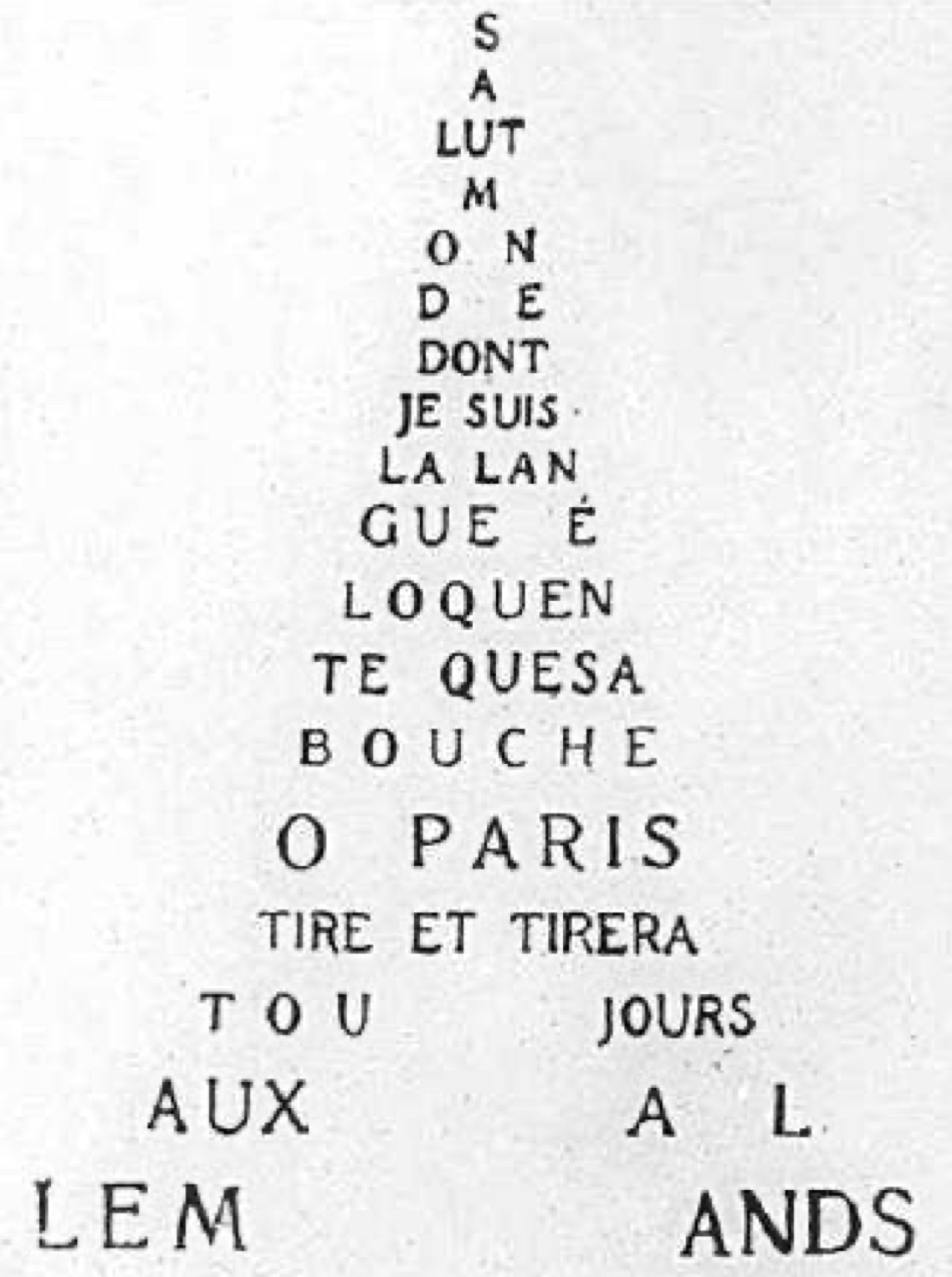
Where to see the Eiffel Tower in art
If writers had mixed feelings about the tower, painters quickly found it a fascinating subject and have continued to do so in the over 130 years since it was built.
Georges Seurat (1859-1891) even painted it before it was completed in 1889, which is why there is no topmost platform to his tower, which just dissolves into the sky. He even painted it darker at the bottom and lighter at the top just like Eiffel had done on the real one. His point of view is from across the river with the Pont d’Iéna (Jena Bridge) in the foreground.
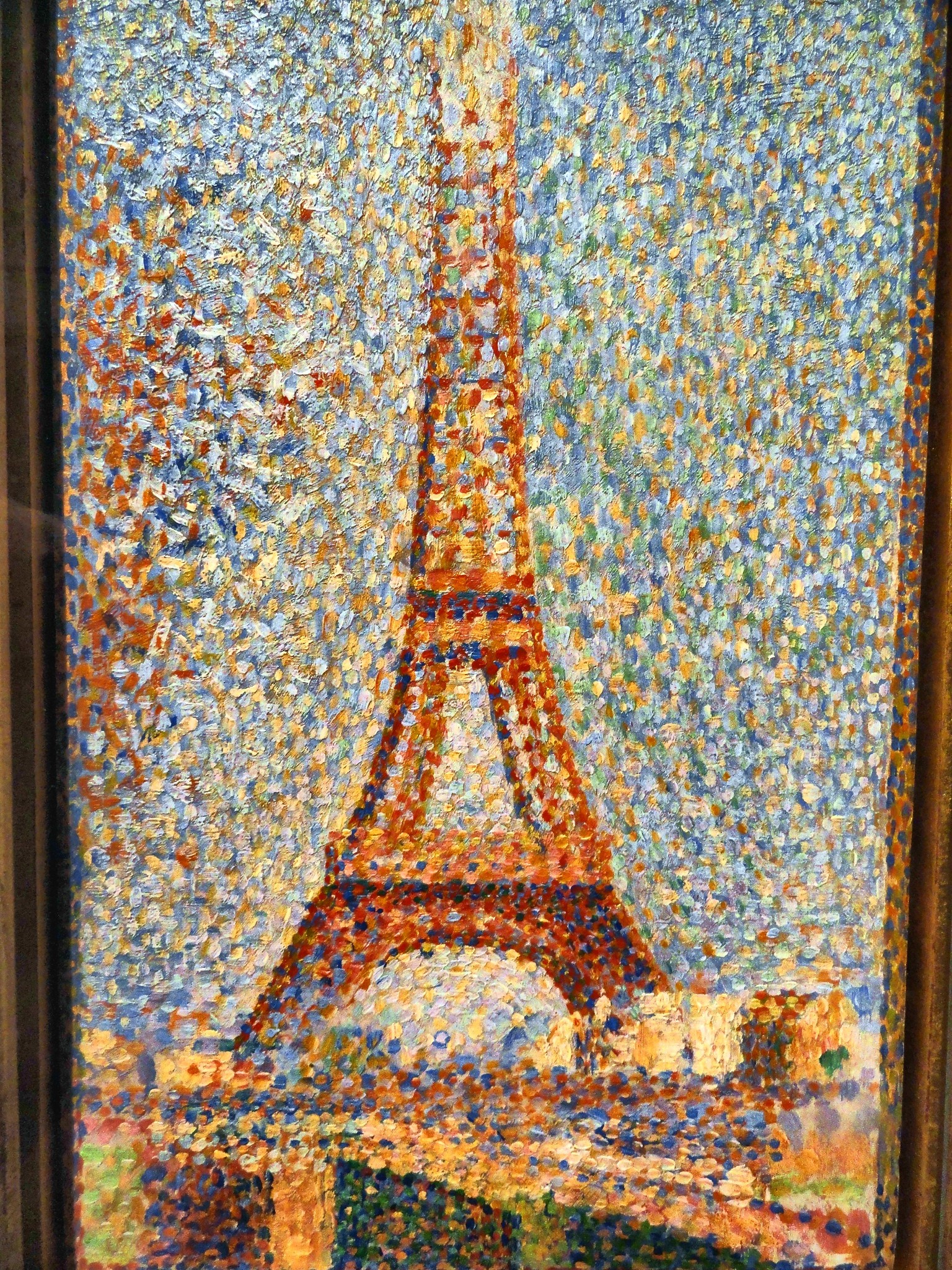
In a similar pointillist style, where the artist builds up the image using dots of paint, Paul Signac (1863-1935) painted an industrial view of the Eiffel Tower seen from the west of Paris. You can just make it out in the top left-hand corner, almost hidden by the smoke from the factories that used to line the Seine downstream from the tower where today there are modern apartment blocks.
If you look carefully, you can see the quarter-sized replica of the Statue of Liberty, given to the Parisians by French residents in the United States.
Fun fact: You’ll notice the torch she is holding in her right hand is on the right, meaning she is facing the Eiffel Tower, looking eastwards so turning her back to the United States. In 1937, she was turned around to look westwards so the same view today would show the torch on her left.
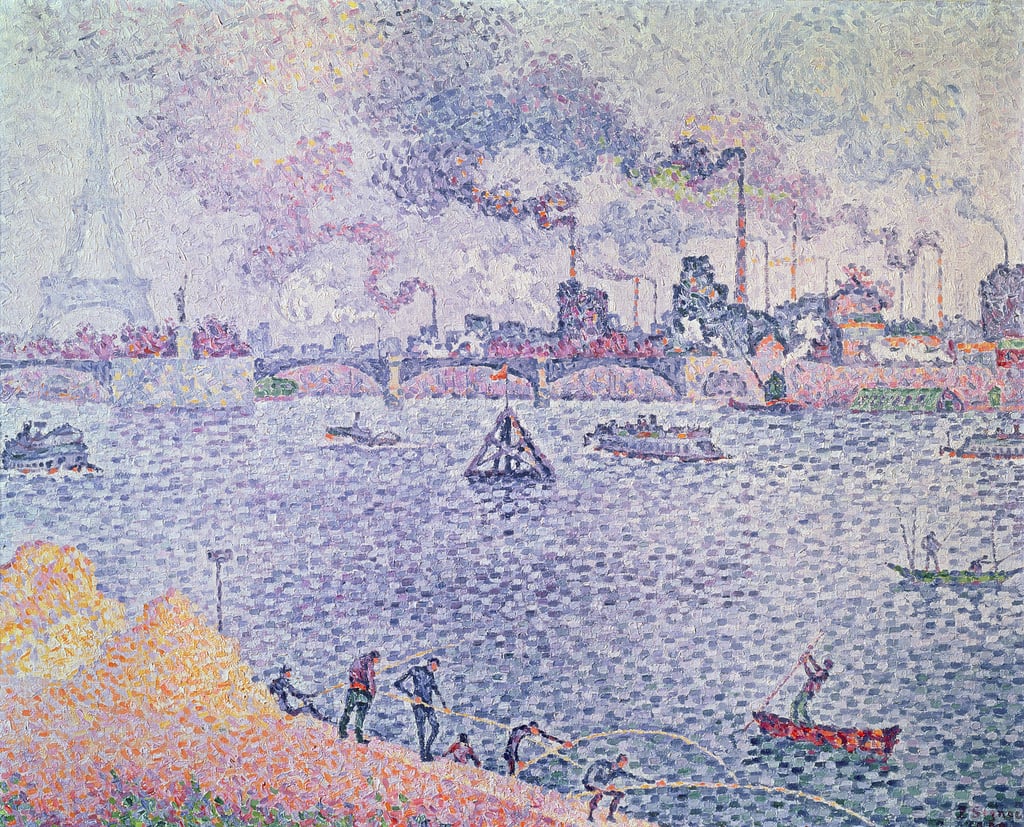
Both Seurat and Signac were Parisian born and bred and, like many other contemporary artists, had workshops in Montmartre. Both are buried in the famous Père Lachaise Cemetery.
Jean Béraud (1849-1935) was a prolific artist, most famous for his depictions of Parisian life, so he obviously could not ignore the Eiffel Tower.
He painted it the year of its inauguration for the Universal Exhibition of 1889. The painting is full of people all walking to see this new-fangled construction on a rather cloudy day.
See it in Paris: You can see this painting at the Musée Carnavalet in Paris.
Another realistic and very detailed view of the Eiffel Tower during the Universal Exhibition was painted by Spanish artist Luis Jiminez Aranda (1845-1928). The woman in the foreground looks to me to be exhausted from visiting the exhibition but I love the detail in this painting.
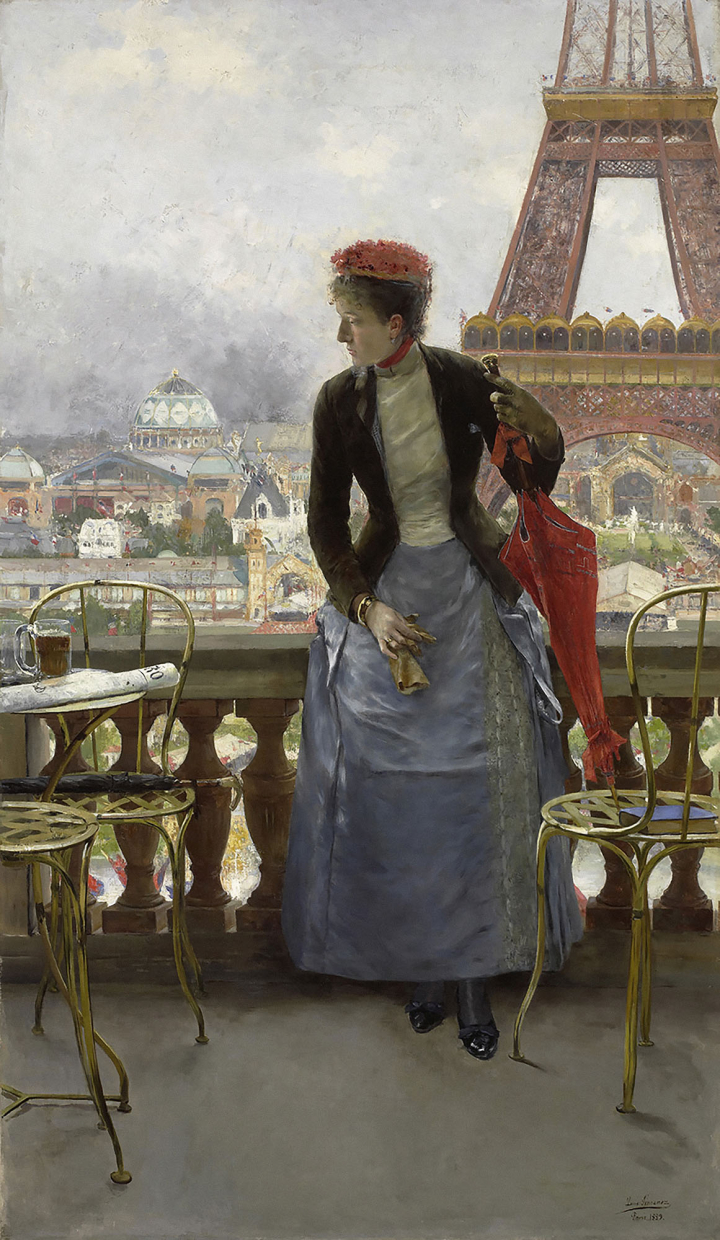
It’s in sharp contrast with the paintings of the Eiffel Tower by Maurice Utrillo (1883- 1955) who specialized in cityscapes. His Paris is almost totally devoid of any people.
The Eiffel Tower appeared in quite a number of Utrillo’s works, always seen from the same one or two spots, sometimes in winter, sometimes in summer. One of the views is from the Avenue de Versailles and I’ve tried to figure out where exactly from, but there are so many new buildings and the trees have grown, so it’s impossible to say. But I did find an old postcard which shows almost exactly the same view in the 1910 floods.
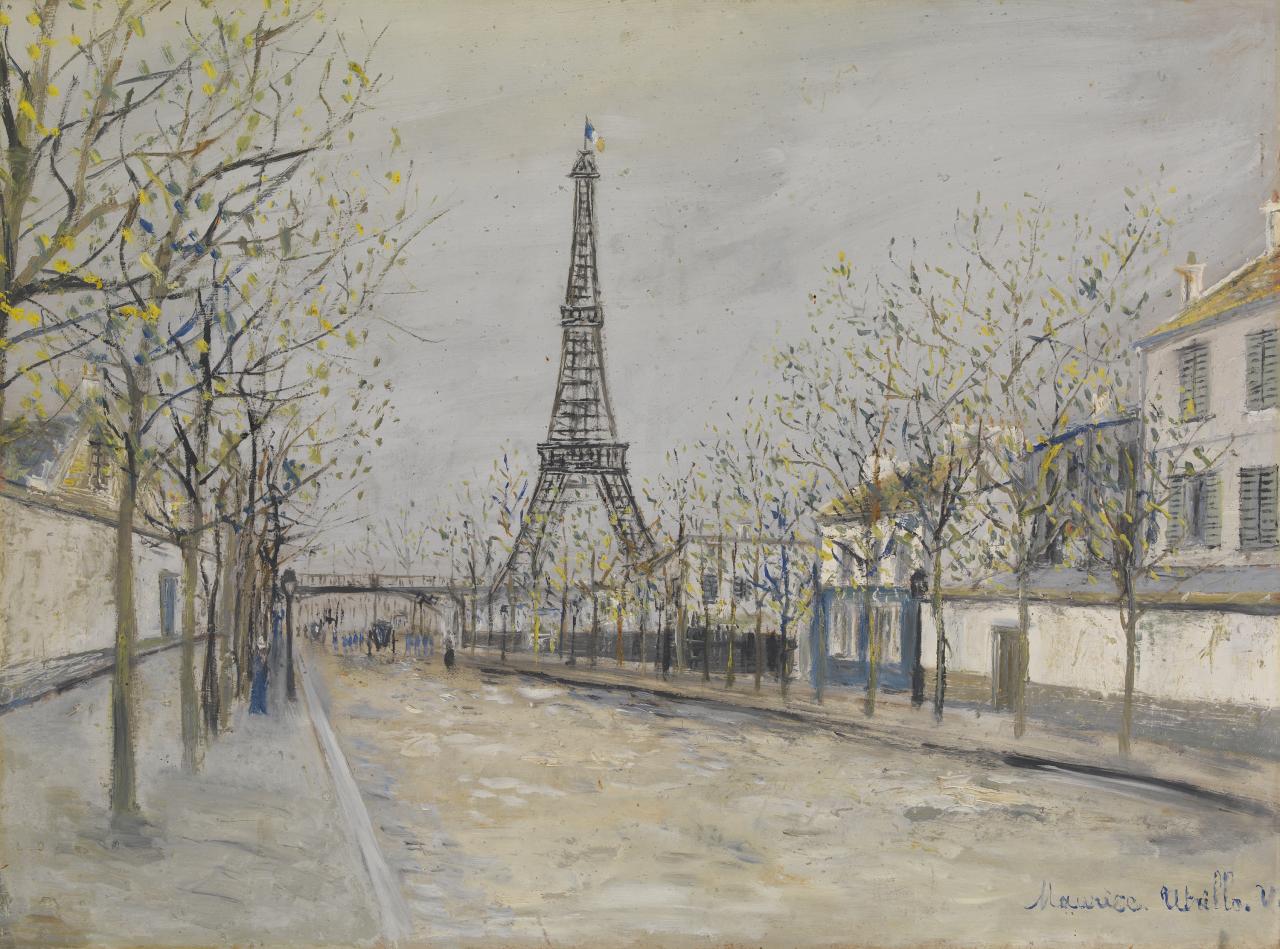
For Robert Delaunay (1885-1941), the Eiffel Tower was as fascinating as the Rouen Cathedral was for Claude Monet.
He painted it 30 times over a period of 20 years. He liked taking different points of view: most remarkably his bird’s eye view inspired by a photograph taken by André Schelcher from an airship. He also painted as though it were about to collapse, from the bottom looking up, from the side, and in all sorts of colors. You can see two of his paintings that feature the Eiffel Tower from the Musée
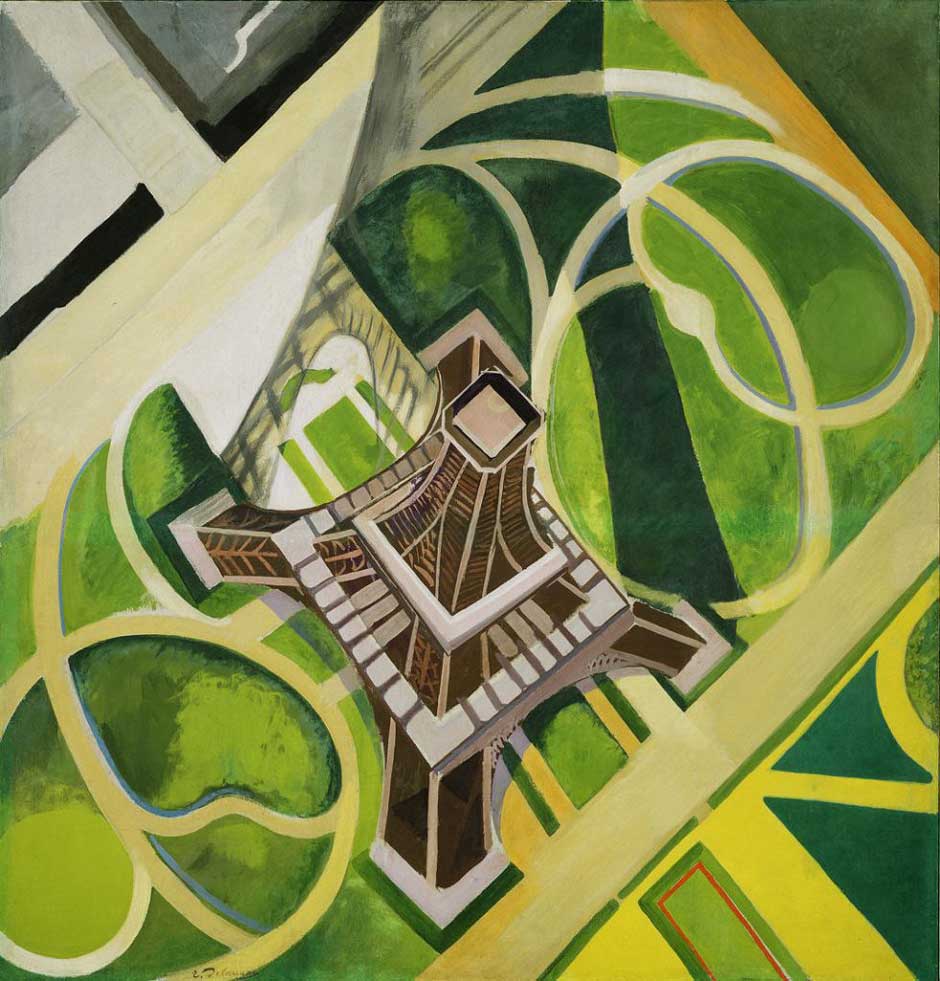
Practical tip: If you go to the Museum of Modern Art in Paris (entry to the permanent collection is free), you’ll see two of Delaunay’s paintings that feature the Eiffel Tower.
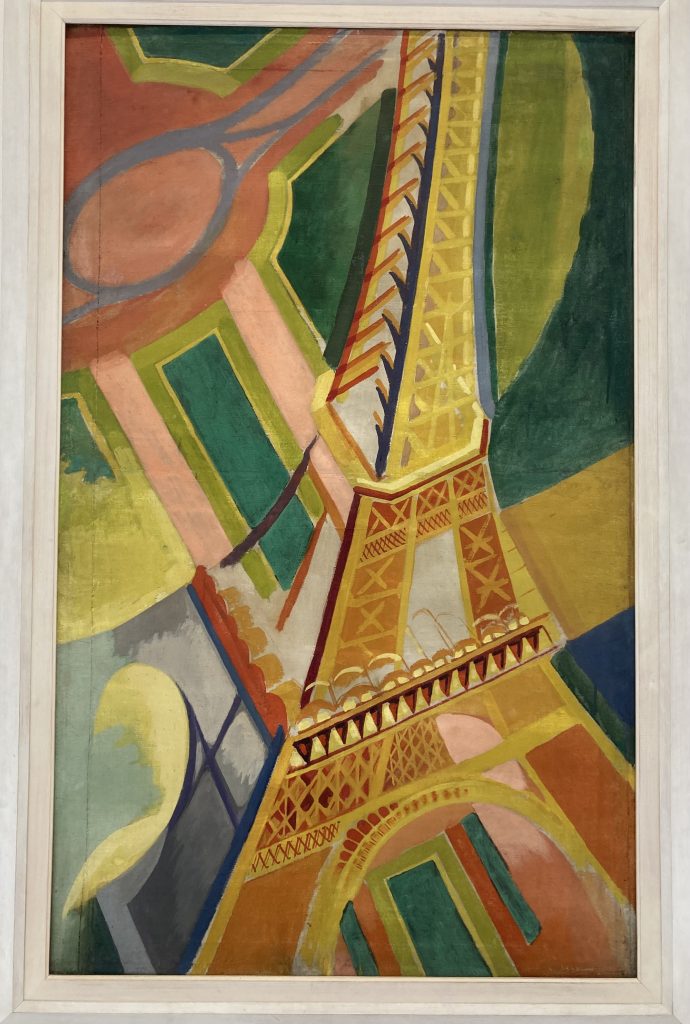
And if you look out of the museum window right next to one of these paintings you can see the real tower! I snapped a photo of it while visiting recently. Take a look.
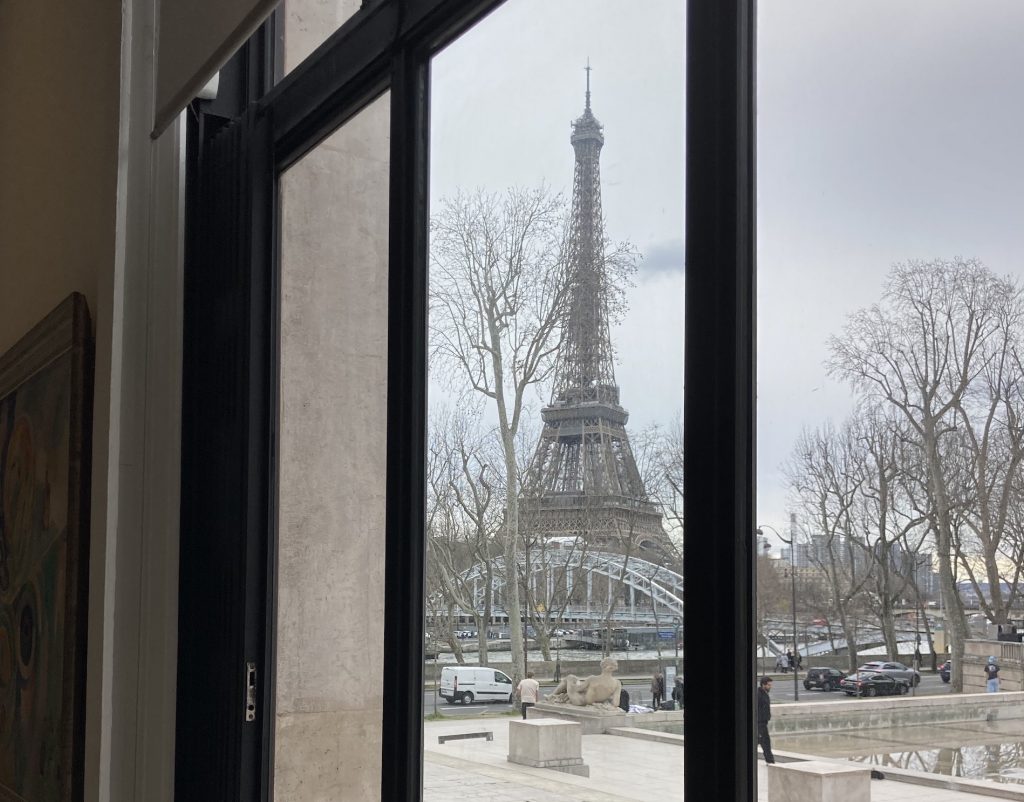
French artist Henri Rivière (1864-1951) published a book in 1902 called “The Thirty Six Views of the Eiffel Tower.”
The book includes lithographs printed between 1888-1902. The artist recollects in his memoirs that he and two friends had gained access to the Eiffel Tower while it was being built and climbed up and down it, but one of his friends suffered from vertigo, and had to be taken down by crane in a cloth bag!
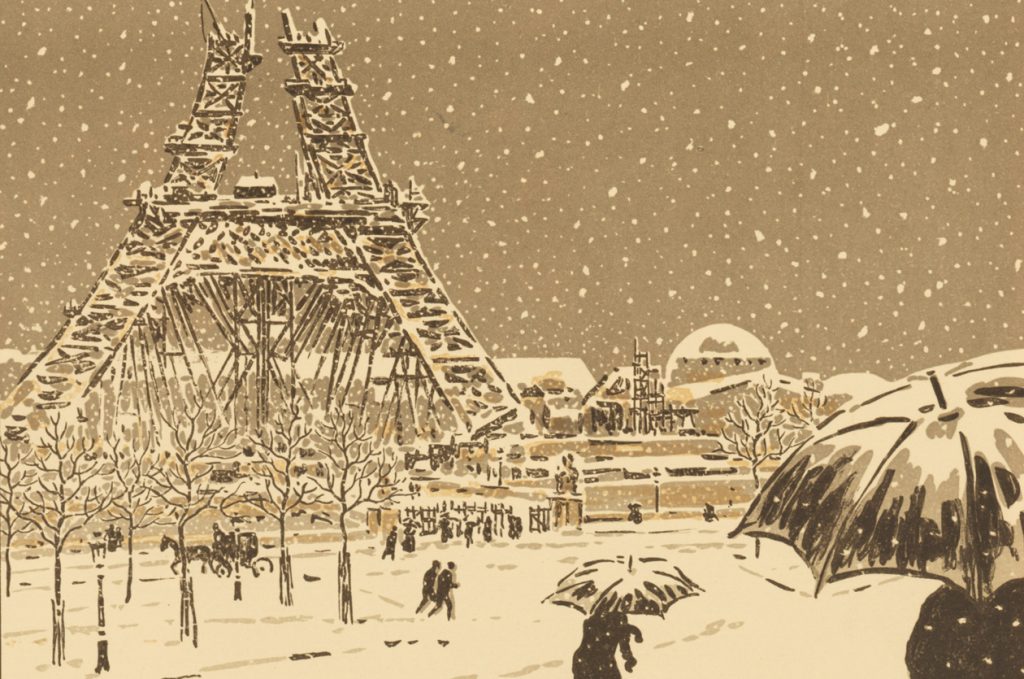
Henri Rousseau (1844-1910), a post-Impressionist artist known for painting in a “naive” manner, only started painting seriously in his early 40s to relax from his job as a customs officer — which is why he’s also sometimes known as Le Douanier (that means “customs officer”).
He painted the Eiffel Tower at least three times. Twice, it’s the main subject but once, he is. In his self-portrait, the tower is barely visible, a bit confused with the ropes and flags of the sailing ship.
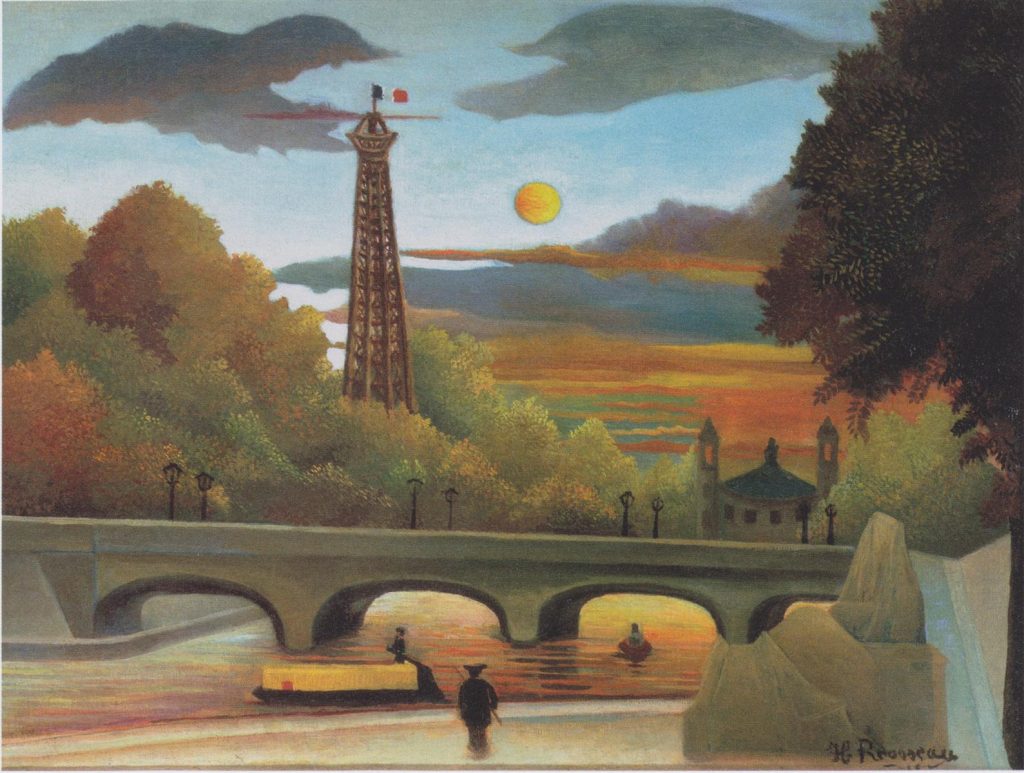
The Eiffel Tower in 20th-century art
The Eiffel Tower appears in at least five paintings by Marc Chagall (1887-1985):
- It is the centerpiece in the colorful “Paris from a Window,” soaring above the rooftops with a man and woman lying at its feet and someone who appears to have parachuted from the summit.
- It is a simple dark shape behind the bride and groom in “The Wedded Couple.”
- It also appears in the unusual “Champ de Mars” from 1954 in which another Parisian landmark, the Montmartre basilica, also appears. Besides the tower, much of the subject matter is a mystery. Have the couple in the center been arguing? Is the young man bringing a bouquet as a gesture of peace encouraged by the dove at the bottom? Who knows?
- “The Concert” painted in 1957 depicts a couple in a boat apparently floating from a blue-enveloped Paris symbolized by the Eiffel Tower toward heavenly musicians.
- “The Players” again has Paris in the background, this time pairing the Eiffel Tower with Notre Dame cathedral and featuring the river Seine and its bridges.
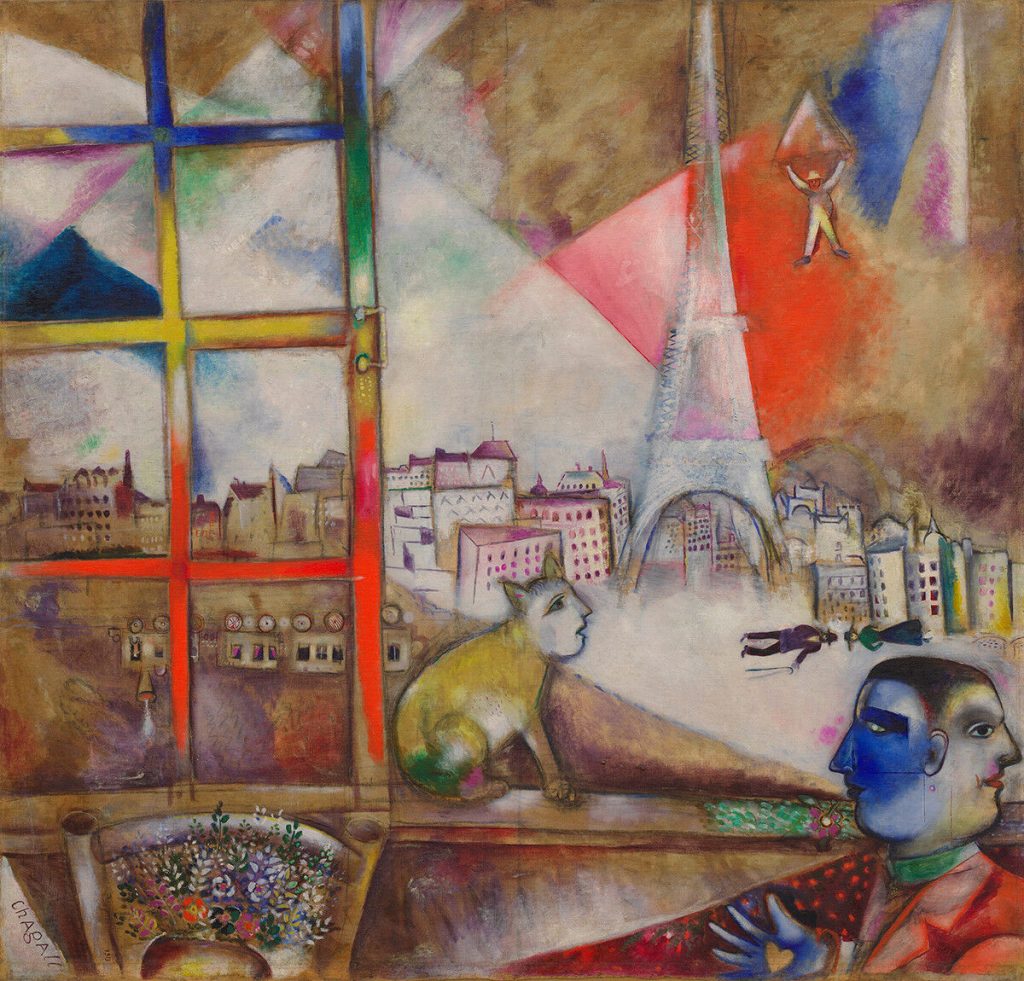
Local tip: if you happen to visit the Palais Garnier while you’re in Paris take a look at the ceiling of the auditorium. It was painted by Chagall.
Nicolas de Staël (1914-1955) refused to be pegged into a particular art movement, and although many of his works are abstract, the Eiffel Tower is clearly recognisable in what seems to me to be a view perhaps from a window over Parisian rooftops in one of his last works.
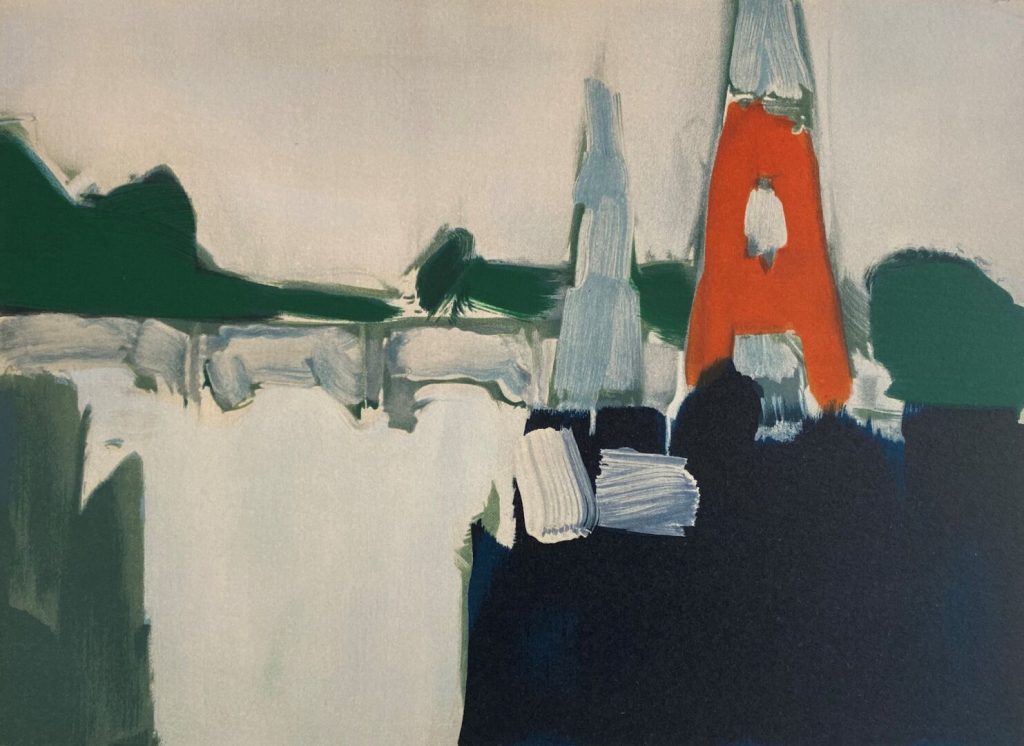
Italian artist Gino Severini (1883-1966), a leading member of the Futurist movement, divided his time between Paris and Rome, and his Eiffel Tower is barely recognisable, all taken apart and in bits and pieces.
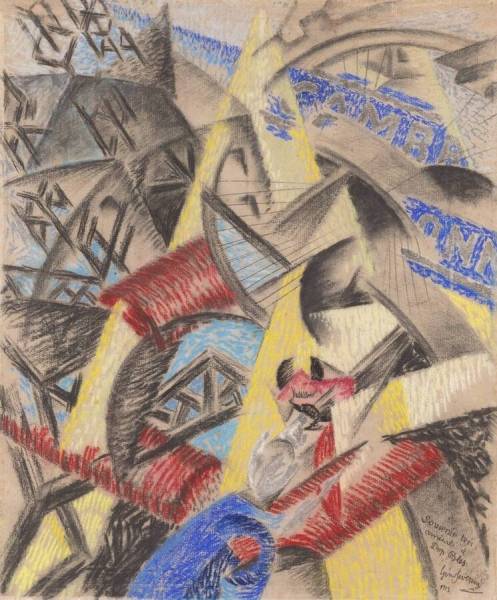
French Expressionist artist Bernard Buffet (1928-1999) also found the Eiffel Tower to be a good subject throughout his life. Sometimes it’s the main subject in a lithograph, sometimes there are people in front, and sometimes it’s just in the background.
I like this one from 1988 which has a little more color than many of his earlier ones.
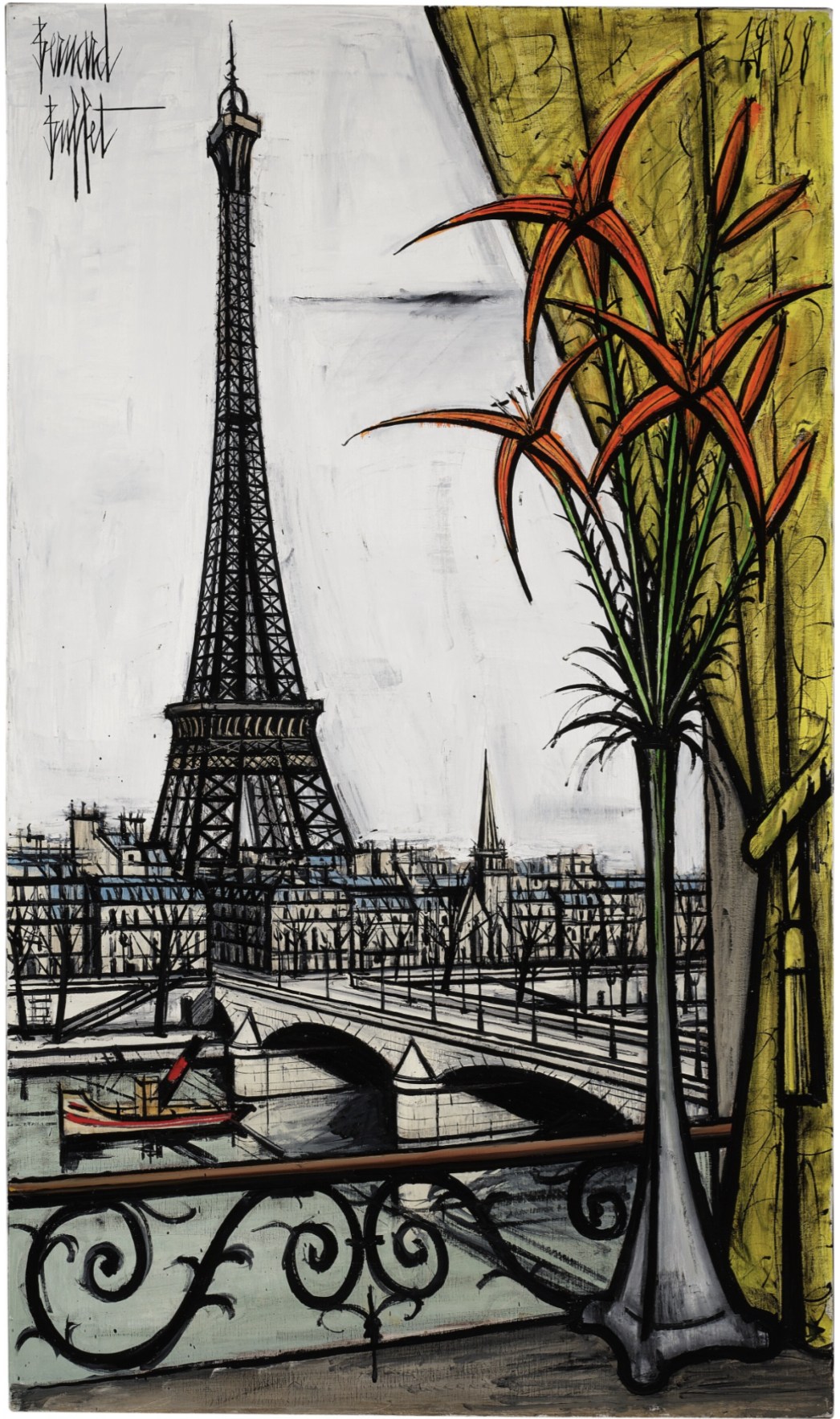
Belgian artist Pol Bury (1922-2005) found the Eiffel Tower an endless source of inspiration. He would cut it up into sections and then rearrange them with the top and bottom upside down for example. Or he’d have it bending over and all squiggly as though reflected in a puddle of oil. Or, as in the brightly colored illustration below, he would pinch and stretch it in different directions.
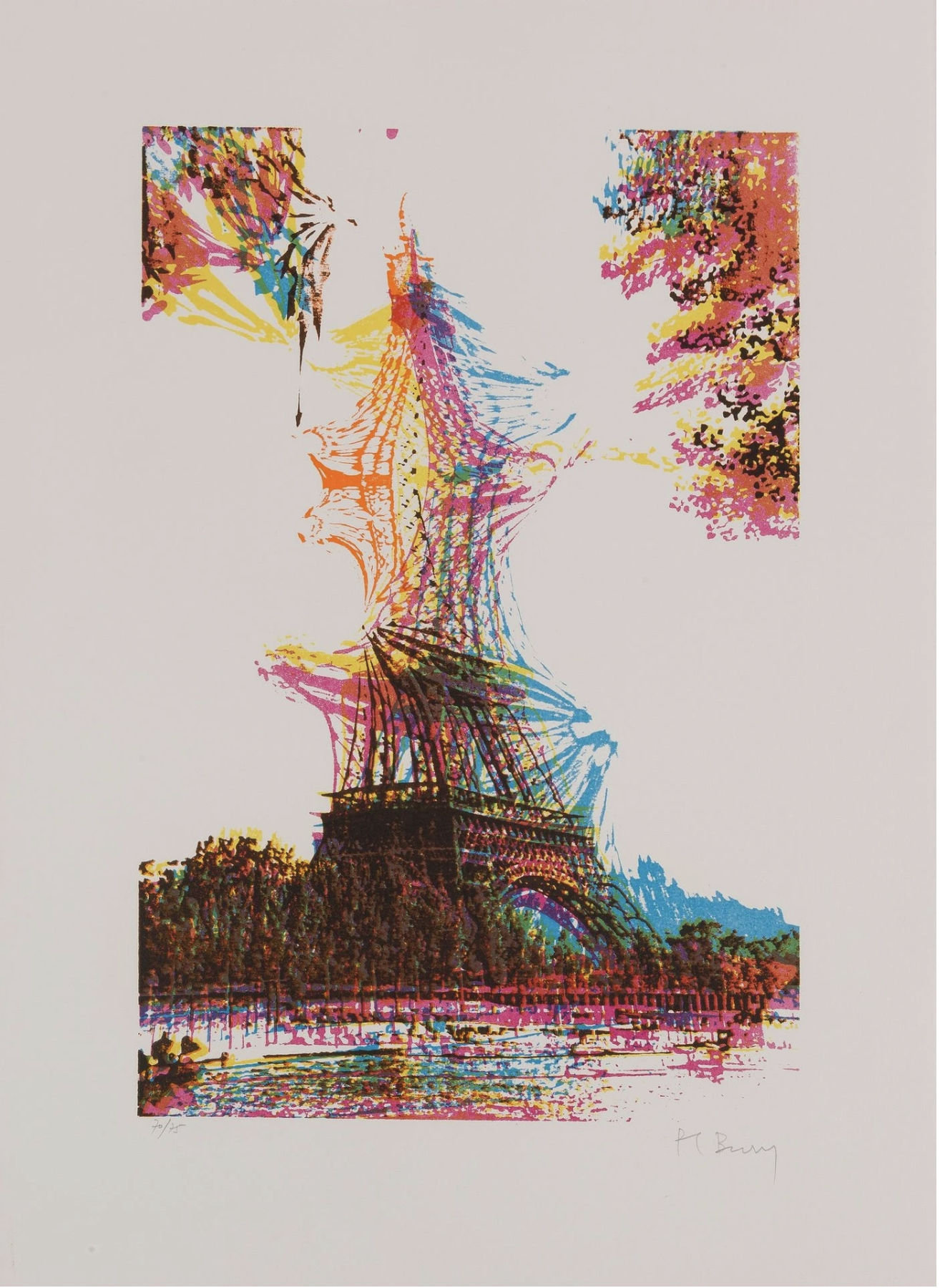
Gustave Eiffel, sitting in his office, would doubtless have been extremely surprised (and likely pleased) to know that art depicting and describing his tower can not only be seen in museums in Paris but also in museums the world over, from New York and San Francisco to Finland, Australia, and the Czech Republic, and many other places besides.
Want to learn more about the tower? See if you’ve fallen for any of these 12 Eiffel Tower myths.
